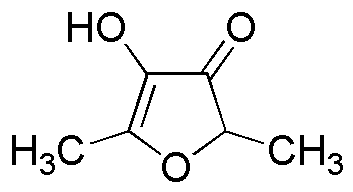2,5-Dimethyl-4-hydroxy-3(2H)-furanone is widely utilized in research focused on:
- Flavoring and Fragrance Industry: This compound is known for its sweet, caramel-like aroma, making it a popular choice in food flavoring and fragrance formulations.
- Food Preservation: It has antioxidant properties that can help extend the shelf life of food products by preventing oxidative spoilage.
- Cosmetic Applications: Due to its pleasant scent and skin-friendly properties, it is often incorporated into cosmetic products such as lotions and creams.
- Pharmaceuticals: The compound is being researched for its potential therapeutic effects, including anti-inflammatory and antimicrobial properties.
- Aromatherapy: Its aromatic qualities make it suitable for use in essential oils and diffusers, promoting relaxation and well-being.
General Information
Properties
Safety and Regulations
Applications
2,5-Dimethyl-4-hydroxy-3(2H)-furanone is widely utilized in research focused on:
- Flavoring and Fragrance Industry: This compound is known for its sweet, caramel-like aroma, making it a popular choice in food flavoring and fragrance formulations.
- Food Preservation: It has antioxidant properties that can help extend the shelf life of food products by preventing oxidative spoilage.
- Cosmetic Applications: Due to its pleasant scent and skin-friendly properties, it is often incorporated into cosmetic products such as lotions and creams.
- Pharmaceuticals: The compound is being researched for its potential therapeutic effects, including anti-inflammatory and antimicrobial properties.
- Aromatherapy: Its aromatic qualities make it suitable for use in essential oils and diffusers, promoting relaxation and well-being.
Documents
Safety Data Sheets (SDS)
The SDS provides comprehensive safety information on handling, storage, and disposal of the product.
Product Specification (PS)
The PS provides a comprehensive breakdown of the product’s properties, including chemical composition, physical state, purity, and storage requirements. It also details acceptable quality ranges and the product's intended applications.
Certificates of Analysis (COA)
Search for Certificates of Analysis (COA) by entering the products Lot Number. Lot and Batch Numbers can be found on a product’s label following the words ‘Lot’ or ‘Batch’.
*Catalog Number
*Lot Number
Certificates Of Origin (COO)
This COO confirms the country where the product was manufactured, and also details the materials and components used in it and whether it is derived from natural, synthetic, or other specific sources. This certificate may be required for customs, trade, and regulatory compliance.
*Catalog Number
*Lot Number
Safety Data Sheets (SDS)
The SDS provides comprehensive safety information on handling, storage, and disposal of the product.
DownloadProduct Specification (PS)
The PS provides a comprehensive breakdown of the product’s properties, including chemical composition, physical state, purity, and storage requirements. It also details acceptable quality ranges and the product's intended applications.
DownloadCertificates of Analysis (COA)
Search for Certificates of Analysis (COA) by entering the products Lot Number. Lot and Batch Numbers can be found on a product’s label following the words ‘Lot’ or ‘Batch’.
*Catalog Number
*Lot Number
Certificates Of Origin (COO)
This COO confirms the country where the product was manufactured, and also details the materials and components used in it and whether it is derived from natural, synthetic, or other specific sources. This certificate may be required for customs, trade, and regulatory compliance.


